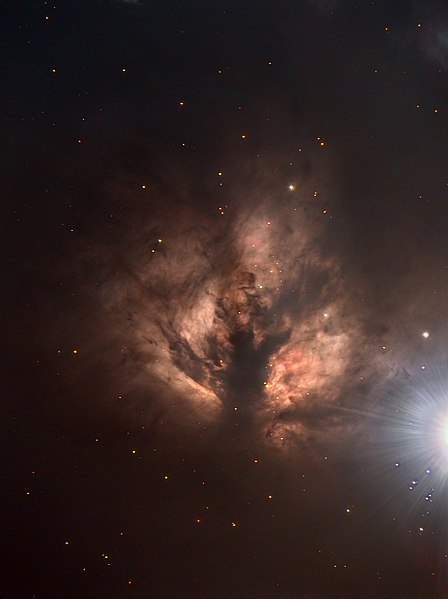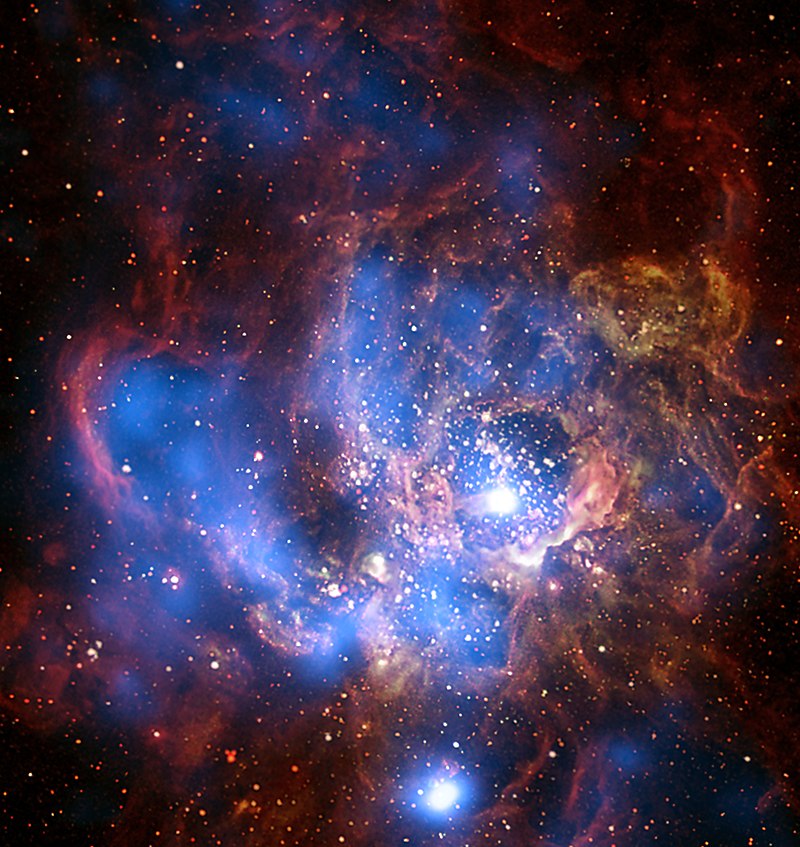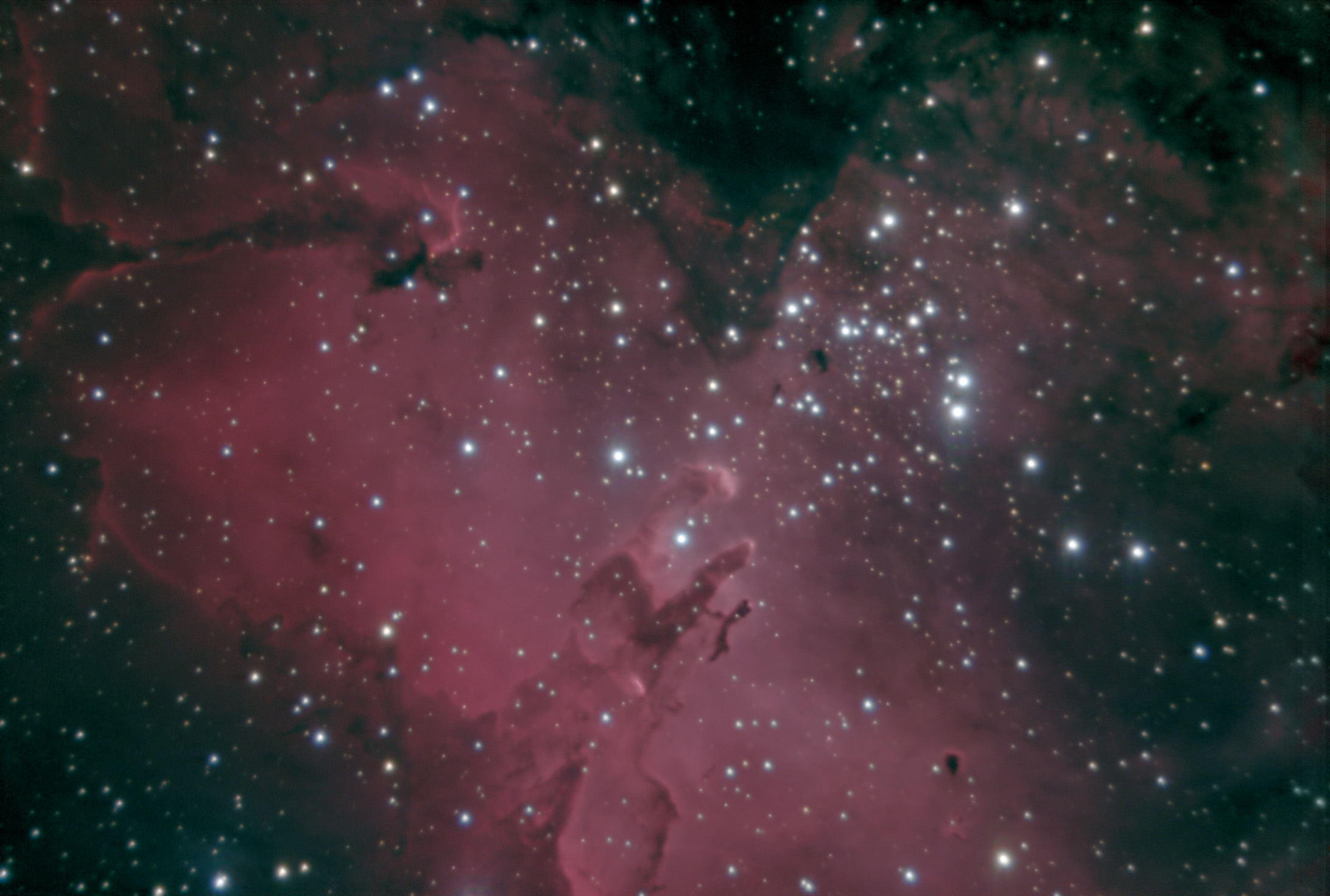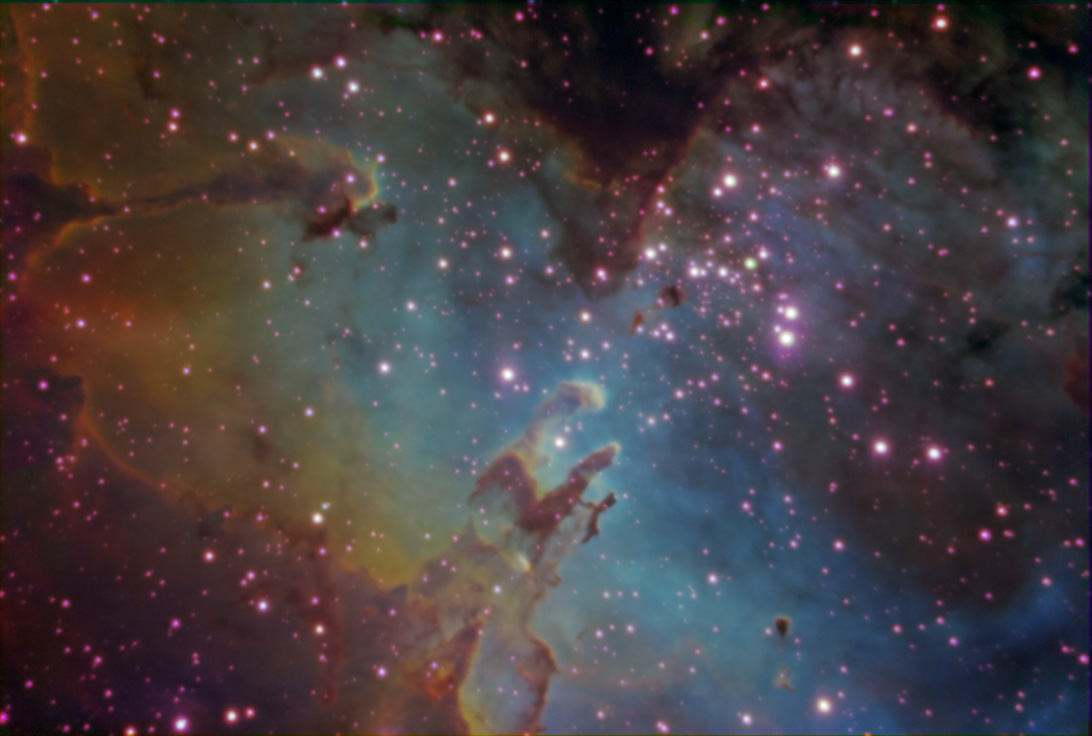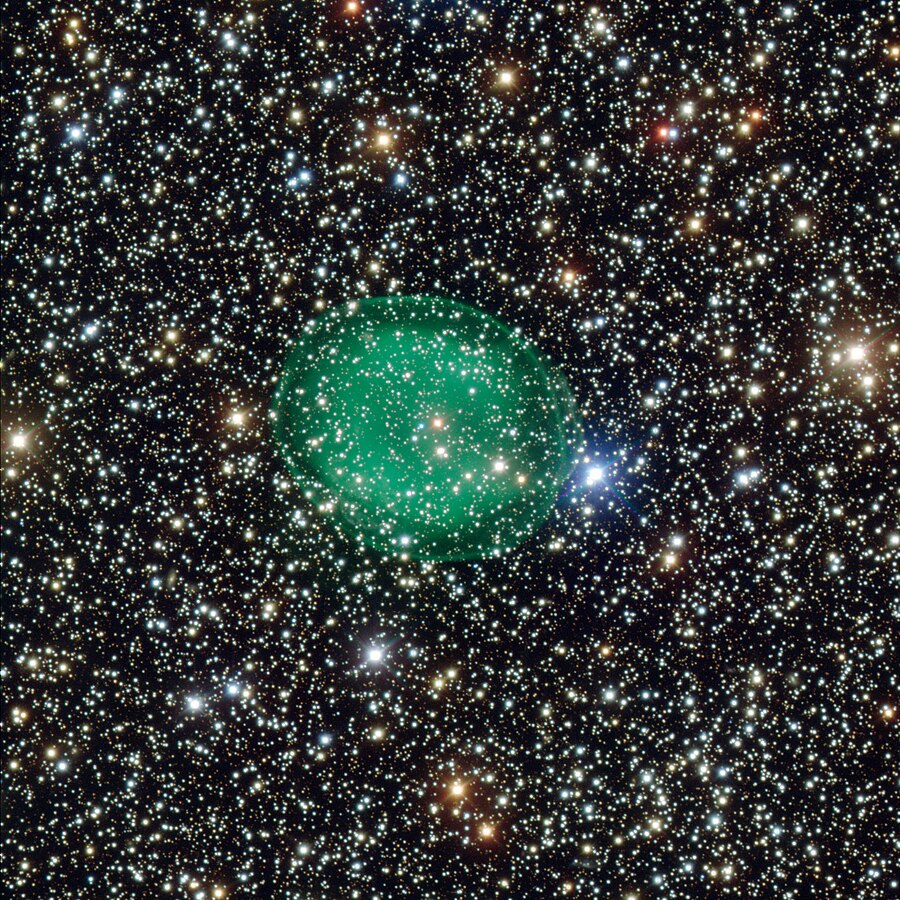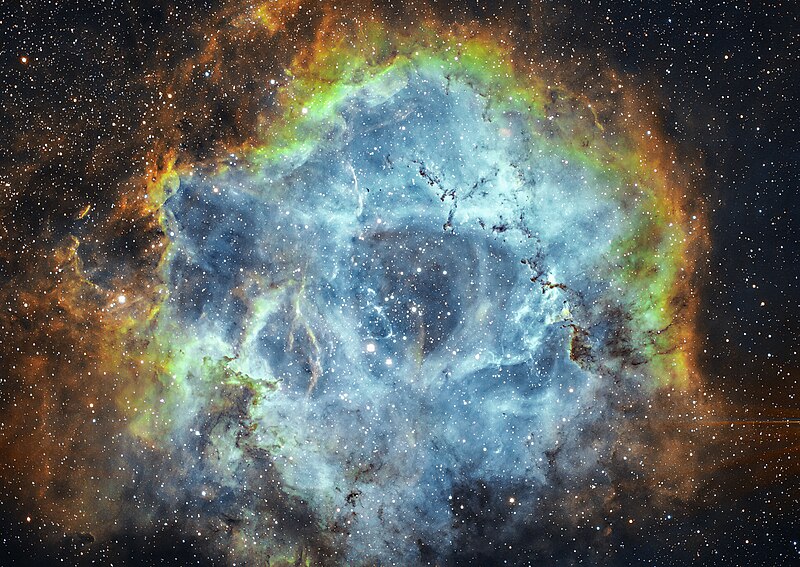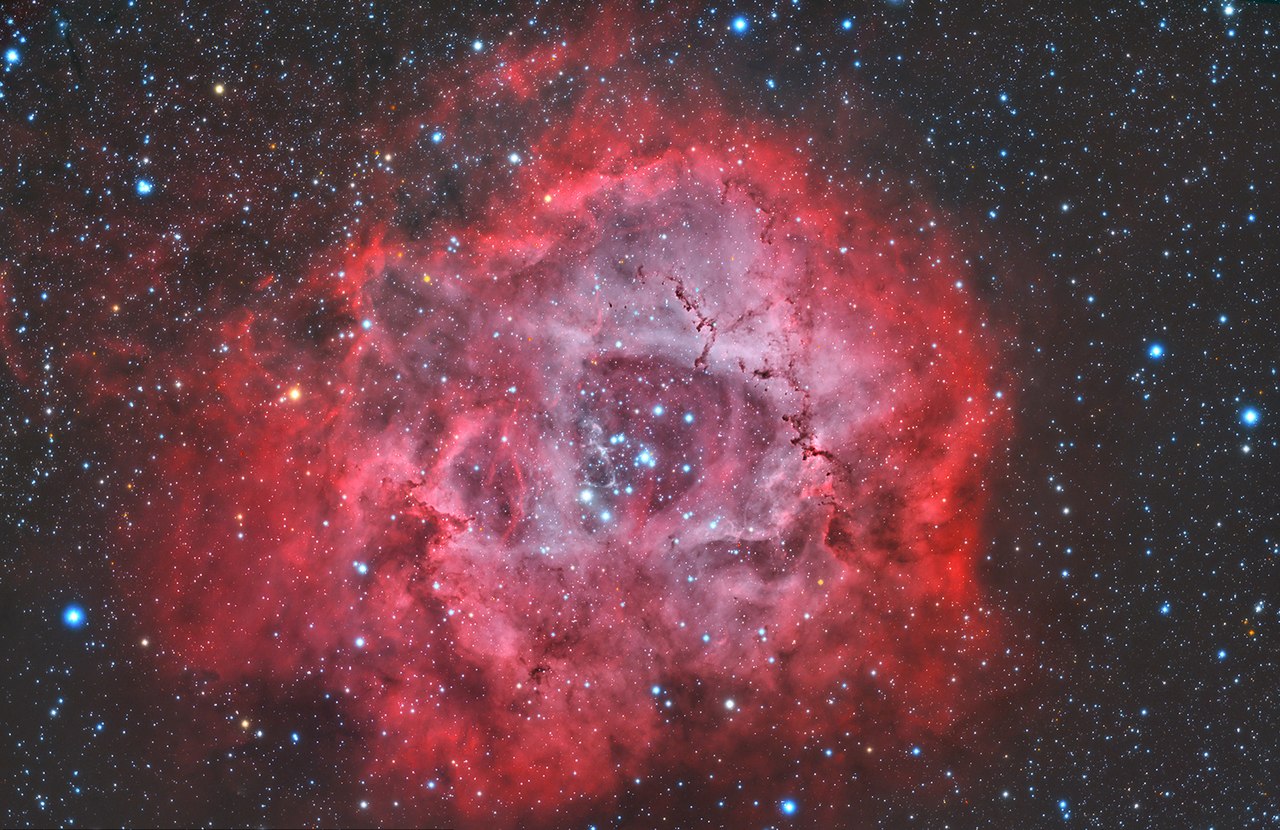MarkBour wrote: ↑Fri Aug 12, 2022 4:19 pm
There's lots to wonder about in this beautiful image.
- To the upper left of the blue patch, is a red and milky white shape that looks like a solar prominence, or a two-thirds of a doughnut. It must be at least 5 light years in diameter. As I look at it, I think it is actually spherical, and the only reason it looks more like a doughnut is because front and center of it is a region of black-appearing dust that obscures the visually central part of it. So, what is it? Is it a planetary nebula? If so, it must have been a massive supernova, right?
- The blue patch, if this is the Hubble palette, must be a lot of oxygen. What could cause an abundance of oxygen in one region of the nebula?
- One can see what appear to be ripples, as if in a pond, all over the image, but most clearly to the lower right of the oxygen patch. I don't think these ripples appear to be centered on the first item in this list, they probably came from some other source. But I'm wondering if the ripples are remnants of a set of shocks that passed through the region of the Pillars of Creation and the Fairy, and set off the star formation that is progressing within them.
I'll belatedly try to answer some of your questions. I'll try, mind you! First, the two-thirds of a doughnut.
The semicircle of a half a doughnut is seen at upper left. It's definitely not a planetary nebula. To me, it is slightly -
slightly, not very - reminiscent of the Flame Nebula:
The similarity between the "half a doughnut" and the Flame Nebula is that they are both found near hot stars, in an environment full of gas and dust, where there has recently been massive star formation going on. formation. The Flame Nebula is a site of star formation.
The huge difference between the Flame Nebula and the semicircle nebula in the Eagle Nebula is that the semicircle is so perfectly regularly formed, whereas the dark dust pillar in front of the Flame Nebula is very tattered and torn. And the upper edges of the Flame Nebula are very diffuse. My guess is that the stubby dust pillar in M16 is more of a foreground object and located quite some distance away from any actual star formation. It is sort of a counterpart to the large triangular kind of semi-transparent pillar hanging down from the "roof" of M16.
But could the semicircular shape have been caused by a supernova? It wouldn't be incredibly surprising to find a supernova here, close to such massive stars. But I don't think it
looks like a supernova remnant. Let's look at NGC 604 in M33 and a supernova remnant in the the Small Magellanic Cloud:

- In the wake of Independence Day festivities surrounding the U.S. July 4th holiday, astronomers and image processors at the Space Telescope Science Institute are releasing the Hubble Space Telescope image of a cosmic explosion that is quite similar to fireworks on Earth. In the nearby galaxy, the Small Magellanic Cloud, a massive star has exploded as a supernova, and begun to dissipate its interior into a spectacular display of colorful filaments. The supernova remnant (SNR), known as 'E0102' for short, is the greenish-blue shell of debris just below the center of the Hubble image. Its name is derived from its cataloged placement (or coordinates) in the celestial sphere. More formally known as 1E0102.2-7219, it is located almost 50 light-years (15 parsecs) away from of the edge of the massive star-forming region, N 76, also known as Henize 1956 in the Small Magellanic Cloud. Credit:
NASA, ESA and the Hubble Heritage Team (STScI/AURA).
In the image at left, we see the bisected NGC 604 in M33, where "the left lobe" is filled with X-rays from past supernovas, whereas the right lobe is filled with X-rays from stellar winds from massive young stars. In the image at right, the supernova remnant (blue and green) is separate from the region of star formation (pink).
I don't think that the semicircle is a supernova remnant. I expect a supernova remnant to "define its own shape", but the semicircle looks like it is defined by foreground dust hanging in front of some kind of "shapeless" ionized background.
Lets take a look at ESO:s BVR "natural-color" portrait of the Eagle Nebula:
In ESO's image, we can see that the ionization level of the semicircle (at upper right) is quite low. It is so low, in fact, that I'd say that it is impossible that any sort of massive star formation is going on behind the stubby dark dust pillar. Instead, I think that the semicircle is simply a (very interestingly shaped) break in the dust cloud cover, revealing scattered rather low-energy ionization from the massive young star cluster ionizing Eagle Nebula itself.
So, on to the blue center of the Eagle Nebula. I think that the first thing we must remember is that the APOD is a narrowband image, so that the emission from a single narrow wavelength can be incredibly dominant in such an image, even if such an image doesn't correspond to that wavelength's actual dominance in the area in question.
A great illustration can be seen
here from Fort Lewis Observatory. There is a "hover image" alternating between an RGB+H-alpha and a Hubble palette image. This is what the two images look like:
As you can see, there is a lot of blue from OIII in the Hubble palette image, but there is no blue at all in the RGB+Hα image, where OIII was not specifically recorded. My point is that there is not
and abundance of OIII in the blue-looking part of the Eagle Nebula, but there is really
some OIII there.
Let's compare it with the ESO "naturl-color" image again:
The part of the Eagle Nebula near the young star cluster is "pale" in color. The overall hue of the nebula bleeds from red at the edges to pink to bluish white at the center. The bluish color is a combination of OIII and scattered light from the hot blue stars themselves, I'd say.
OIII emission is seen in rarefied regions near extremely hot stars, where there is very little gas and enormous amounts of ultraviolet photons. We do see
some OIII in nebulas surrounding very hot young stars, such as the Eagle Nebula and the Orion Nebula.But the only place where OIII is dominant to the point that we can actually see the color of it in ordinary RGB images is in planetary nebulas (and not even in all planetary nebulas, but in most of them):
The green color in planetary nebula IC 1295 is "true". This nebula has got no (or extremely little) hydrogen, and virtually all the light from the nebula is the green light of OIII. The OIII is quite bright here.
So, in short: The very blue part of the Eagle Nebula seen in the APOD is so blue because of the choice of filters used for the image, and also because of choices made during processing.
Compare these two images of the Rosette Nebula:
Why is there so much blue in one of the Rosette Nebula images, and hardly any blue at all in the other one? It's because of the filters used and the choices made during processing.
Ann
 Portrait of the Eagle Nebula
Portrait of the Eagle Nebula
